Ethnic minorities in China
Ethnic minorities in China are the non-Han Chinese population in China. China officially recognizes 55 ethnic minority groups within China in addition to the Han majority.[1] As of 2010, the combined population of officially recognized minority groups comprised 8.49% of the population of mainland China.[2] In addition to these officially recognized ethnic minority groups, there are Chinese nationals who privately classify themselves as members of unrecognized ethnic groups (such as Jewish, Tuvan, Oirat, Ili Turki, and Japanese).
The ethnic minority groups officially recognized by the PRC reside within mainland China and Taiwan, whose minorities are called the Taiwanese aborigines. The Republic of China (ROC) in Taiwan officially recognises 14 Taiwanese aborigine groups, while the PRC classifies them all under a single ethnic minority group, the Gaoshan. Hong Kong and Macau do not use this ethnic classification system, and figures by the PRC government do not include the two territories.
By definition, these ethnic minority groups, together with the Han majority, make up the greater Chinese nationality known as zhonghua minzu. Chinese minorities alone are referred to as "shaoshu minzu".
Summary of varieties of Chinese
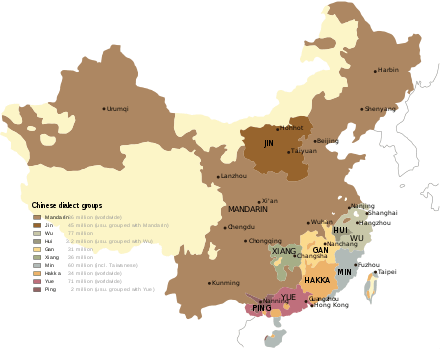
The number of speakers derived from statistics or estimates (2019) and were rounded:[3][4][5]
| Number | Branch | Native Speakers | Dialects |
|---|---|---|---|
| 1 | Mandarin | 850,000,000 | 51 |
| 2 | Wu | 95,000,000 | 37 |
| 3 | Yue | 80,000,000 | 52 |
| 4 | Jin | 70,000,000 | 6 |
| 5 | Min | 60,000,000 | 61 |
| 6 | Hakka | 55,000,000 | 10 |
| 7 | Xiang | 50,000,000 | 25 |
| 8 | Gan | 30,000,000 | 9 |
| 9 | Huizhou | 7,000,000 | 13 |
| 10 | Pinghua | 3,000,000 | 2 |
| Total | Chinese | 1,300,000,000 | 266 |
Han Chinese subgroups
The number of speakers derived from statistics or estimates (2019) and were rounded:[6][7][8]
Summary
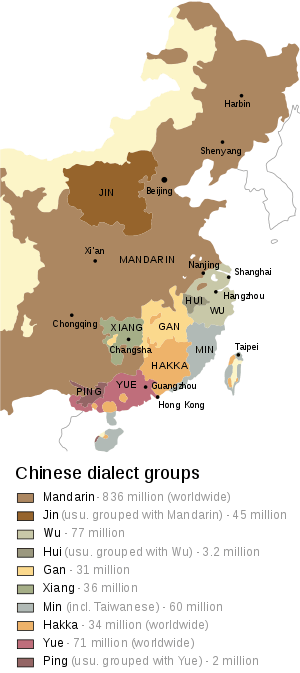
Ethnic minorities with low populations (less than 100,000 individuals) were not taken into account for this project.[9]
Mandarin
- 官话/官話
The number of speakers derived from statistics or estimates (2019) and were rounded:[10]
| Number | Branch | Native Speakers | Dialects |
|---|---|---|---|
| 1 | Beijing | 35,000,000 | 7 |
| 2 | Ji–Lu | 110,000,000 | 4 |
| 3 | Jianghuai | 80,000,000 | 6 |
| 4 | Jiao–Liao | 35,000,000 | 4 |
| 5 | Lan–Yin | 10,000,000 | 3 |
| 6 | Northeastern | 100,000,000 | 4 |
| 7 | Southwestern | 280,000,000 | 11 |
| 8 | Zhongyuan | 200,000,000 | 11 |
| Total | Mandarin | 850,000,000 | 50 |
Ethnic Hans
- Beijing Hans
- Chonqing Hans
- Gan Hans
- Gansu Hans
- Guizhou Hans
- Hainan Hans
- Hakka Hans
- Hebei Hans
- Heilongjian Hans
- Henan Hans
- Hubei Hans
- Jiaoliao Hans
- Jilin & Liaoning Hans
- Lower Yangtze Hans
- Min Hans
- Shaanxi Hans
- Shandong Hans
- Shanxi Hans
- Sichuan Hans
- Taiwan Hans
- Tianjin Hans
- Wu Hans
- Xiang Hans
- Yue Hans
- Yunnan Hans
Ethnic minorities
- Bai
- Chinese Koreans
- Dai
- Dong
- Evenki
- Hani
- Hui
- Jingpo
- Kazakhs
- Kyrgyz
- Lahu
- Li
- Lisu
- Manchus
- Miao
- Taiwan Aborigines
- Tajiks
- Tibetans
- Tujia
- Uyghurs
- Wa
- Yao
- Yi
- Zhuang
Mongols
- Buryats
- Chinese Mongols
- Daurs
- Khalka Mongols
- Oirat Mongols
- Sartuul Mongols
Naming
The Chinese-language term for ethnic minority is "shaoshu minzu" (simplified Chinese: 少数民族; traditional Chinese: 少數民族; pinyin: shǎoshù mínzú; lit.: 'minority race/ethnicity'). In early PRC documents, such as the 1982 constitution,[11] the word "minzu" was translated as "nationality", following the Soviet Union's use of Marxist-Leninist jargon. However, the Chinese word does not imply that ethnic minorities in China are not Chinese citizens, as in fact they are.[12] Following the dissolution of the Soviet Union, governmental and scholarly publications have retranslated "minzu" in the ethnic minority sense into English as "ethnic groups". Some scholars, to be even more precise, use the neologism zuqun (Chinese: 族群; pinyin: zǔqún) to unambiguously refer to ethnicity when "minzu" is needed to refer to nationality.[13]
History of ethnicity in China
Early history
Throughout much of recorded Chinese history, there was little attempt by Chinese authors to separate the concepts of nationality, culture, and ethnicity.[15] Those outside of the reach of imperial control and dominant patterns of Chinese culture were thought of as separate groups of people regardless of whether they would today be considered as a separate ethnicity. The self-conceptualization of Han largely revolved around this center-periphery cultural divide. Thus, the process of Sinicization throughout history had as much to do with the spreading of imperial rule and culture as it did with actual ethnic migration.
This understanding persisted (with some change in the Qing under the import of Western ideas) up until the Communists took power in 1949. Their understanding of minorities had been heavily influenced by the Soviet models of Joseph Stalin—as has been the case for the neighbouring Communist regimes of Vietnam and Laos[16]—and the Soviet definition of minorities did not map cleanly onto this Chinese historical understanding. Soviet thinking about minorities was that a nation was made up of those with a common language, historical culture, and territory. Each nation of these people then had the theoretical right to secede from a proposed federated government.[17] This differed from the previous way of thinking mainly in that instead of defining all those under imperial rule as Chinese, the nation (as defined as a space upon which power is projected) and ethnicity (the identity of the governed) were now separate; being under central rule no longer automatically meant being defined as Chinese. The Soviet model as applied to China gave rise to the autonomous regions in China; these areas were thought to be their own nations that had theoretical autonomy from the central government.[18]
During World War II, the American Asiatic Association published an entry in the text "Asia: journal of the American Asiatic Association, Volume 40", concerning the problem of whether Chinese Muslims were Chinese or a separate "ethnic minority", and the factors which lead to either classification. It tackled the question of why Muslims who were Chinese were considered a different race from other Chinese, and the separate question of whether all Muslims in China were united into one race. The first problem was posed with a comparison to Chinese Buddhists, who were not considered a separate race.[19] It concluded that the reason Chinese Muslims were considered separate was because of different factors like religion, culture, military feudalism, and that considering them a "racial minority" was wrong. It also came to the conclusion that the Japanese military spokesman was the only person who was propagating the false assertion that Chinese Muslims had "racial unity", which was disproven by the fact that Muslims in China were composed of multitudes of different races, separate from each other as were the "Germans and English", such as the Mongol Hui of Hezhou, Salar Hui of Qinghai, and Chan Tou Hui of Turkistan. The Japanese were trying to spread the lie that Chinese Muslims were one race, in order to propagate the claim that they should be separated from China into an "independent political organization".[20]
Distinguishing nationalities in the People's Republic of China
To determine how many of these nations existed within China after the revolution of 1949, a team of social scientists was assembled to enumerate the various ethnic nations. The problem that they immediately ran into was that there were many areas of China in which villages in one valley considered themselves to have a separate identity and culture from those one valley over.[21] According each village the status of nation would be absurd and would lead to the nonsensical result of filling the National People's Congress with delegates all representing individual villages. In response, the social scientists attempted to construct coherent groupings of minorities using language as the main criterion for differentiation. This led to a result in which villages that had very different cultural practices and histories were lumped under the same ethnic name. The Zhuang is one such example; the ethnic group largely served as a catch-all collection of various hill villages in Guangxi province.[22]
The actual census taking of who was and was not a minority further eroded the neat differentiating lines the social scientists had drawn up. Individual ethnic status was often awarded based on family tree histories. If one had a father (or mother, for ethnic groups that were considered matrilineal) that had a surname considered to belong to a particular ethnic group, then one was awarded the coveted minority status. This had the result that villages that had previously thought of themselves as homogenous and essentially Han were now divided between those with ethnic identity and those without.[23]
The team of social scientists that assembled the list of all the ethnic groups also described what they considered to be the key differentiating attributes between each group, including culture, custom, and language. The center then used this list of attributes to select representatives of each group to perform on television and radio in an attempt to reinforce the government's narrative of China as a multi-ethnic state and to prevent the culture of the minority ethnic groups from assimilating by the Han and the rest of the world.[24] However, with the development of modern technology, these attempts brought little effect. In fact, many of those labeled as specific minorities bore no relationship to the music, clothing, and other practices presented with images and representations of "their people" in the media.
Under this process, 39 ethnic groups were recognized by the first national census in 1954. This further increased to 54 by the second national census in 1964, with the Lhoba group added in 1965. The last change was the addition of the Jino people in 1979, bringing the number of recognized ethnic groups to the current 56.
Reform and opening up
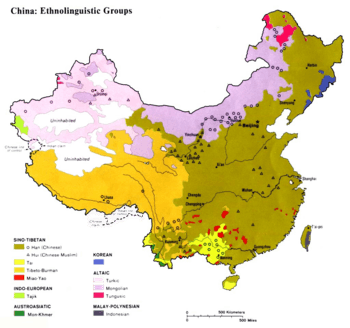
However, as China opened up and reformed post-1979, many Han acquired enough money to begin to travel. One of the favorite travel experiences of the wealthy was visits to minority areas, to see the exotic rituals of the minority peoples.[26][27] Responding to this interest, many minority entrepreneurs, despite themselves perhaps never having grown up practicing the dances, rituals, or songs themselves, began to cater to these tourists by performing acts similar to what the older generation or the local residents told. In this way, the groups of people named Zhuang or other named minorities have begun to have more in common with their fellow co-ethnics, as they have adopted similar self-conceptions in response to the economic demand of consumers for their performances.
After the breakup of Yugoslavia and the dissolution of the Soviet Union, there was a shift in official conceptions of minorities in China: rather than defining them as "nationalities", they became "ethnic groups". The difference between "nationality" and "ethnicity", as Uradyn Erden-Bulag describes it, is that the former treats the minorities of China as societies with "a fully functional division of labor", history, and territory, while the latter treats minorities as a "category" and focuses on their maintenance of boundaries and their self-definition in relation to the majority group. These changes are reflected in uses of the term minzu and its translations. The official journal Minzu Tuanjie changed its English name from Nationality Unity to Ethnic Unity in 1995. Similarly, the Central University for Nationalities changed its name to Minzu University of China. Scholars began to prefer the term zuqun (族群) over minzu.[28] The Chinese model for identifying and categorizing ethnic minorities established at the founding of the PRC followed the Soviet model, drawing inspiration from Joseph Stalin's 1953 'four commons' criteria to identify ethnic groups- "(1) a distinct language; (2) a recognized indigenous homeland or common territory; (3) a common economic life; and (4) a strong sense of identity and distinctive customs, including dress, religion and foods."
The categorization of 55 minority groups was a major step forward from denial of the existence of different ethnic groups in China which had been the policy of Sun Yet-Sen's Nationalist government that came to power in 1911, which also engaged in the common use of derogatory names to refer to minorities (a practice officially abolished in 1951). However, the Communist Party's categorization was also rampantly criticized since it reduced the number of recognized ethnic groups by eightfold, and today the wei shibie menzu (literally "undistinguished ethnic groups") total more than 730,000 people. These groups include Geija, Khmu, Kucong, Mang, Deng, Sherpas, Bajia, Yi and Youth (Jewish).
Ethnic groups
China is officially composed of 56 ethnic groups (55 minorities plus the dominant Han). However, some of the ethnic groups as classified by the PRC government contain, within themselves, diverse groups of people. Various groups of the Miao minority, for example, speak different dialects of the Hmong–Mien languages, Tai–Kadai languages, and Chinese, and practice a variety of different cultural customs.[29] Whereas in many nations a citizen's minority status is defined by their self-identification as an ethnic minority, in China minority nationality (xiaoshu minzu) is fixed at birth, a practice that can be traced to the foundation of the PRC, when the Communist Party commissioned studies to categorize and delineate groups based on research teams' investigation of minorities' social history, economic life, language and religion in China's different regions.
The degree of variation between ethnic groups is not consistent. Many ethnic groups are described as having unique characteristics from other minority groups and from the dominant Han, but there are also some that are very similar to the Han majority group. Most Hui Chinese are indistinguishable from Han Chinese except for the fact that they practice Islam, and most Manchu are considered to be largely assimilated into dominant Han society.
China's official 55 minorities are located primarily in the south, west, and north of China. Only Tibet Autonomous Region and Xinjiang Uygur Autonomous Region have a majority population of official minorities, while all other provinces, municipalities and regions of China have a Han majority. In Beijing itself, the Han ethnic composition makes up nearly 96% of the total population, while the ethnic minority total is 4.31%, or a population of 584,692 (as of 2008).
Much of the dialog within China regarding minorities has generally portrayed minorities as being further behind the Han in progress toward modernization and modernity. Minority groups are often portrayed as rustic, wild, and antiquated. As the government often portrays itself as a benefactor of the minorities, those less willing to assimilate (despite the offers of assistance) are portrayed as masculine, violent, and unreasonable. Groups that have been depicted this way include the Tibetans, Uyghurs and the Mongols.[30] Groups that have been more willing to assimilate (and accept the help of the government) are often portrayed as feminine and sexual, including the Miao, Tujia and the Dai.[24]
The Taiwanese aboriginals include more than 14 Taiwanese aboriginal groups called Gaoshanzu by the mainland Chinese government. This is a special situation for Taiwanese minorities, because indigenous Taiwanese comprise a number of different ethnic groups with somewhat different languages and cultures. By the Taiwanese government's official records, Taiwan has 22 tribes with different cultures and languages. Among these are the Amis, Atayal, Bunun, Hla’alua, Kanakanavu, Kavalan, Taiwan, Puyuma, Rukai, Saisiat, Sakizaya, Seediq, Thao, Truku, Tsou, and Yami. According to the article "Taiwanese Aborigines – the Natives of Taiwan", there are about 530,000 indigenous Taiwanese, accounting for 2.3% of the population. While many indigenous Taiwanese lived in the mountains many have since migrated to the cities. Taiwanese Aboriginals also lived on the western plains. They were called Pingpu by Han settlers. They have been assimilated by them. 85% of all Taiwanese people might have some degree of aboriginal bloodline.[31]
Demographics of the ethnic minorities
The largest ethnic group, Han, according to a 2005 sampling, constitute about 91.9% of the total population. The next largest ethnic groups in terms of population include the Zhuang (18 million), Manchu (15 million), Hui (10 million), Miao (9 million), Uyghur (8 million), Yi (7.8 million), Tujia (8 million), Mongols (5.8 million), Tibetans (5.4 million), Buyei (3 million), Yao (3.1 million), and Koreans (2.5 million). Minority populations are growing fast due to their being unaffected by the One Child Policy.[32]
Guarantee of rights and interests
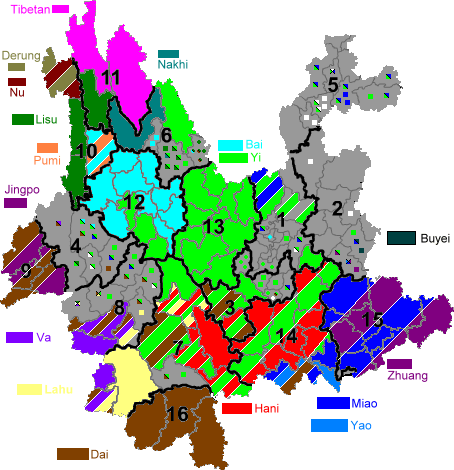
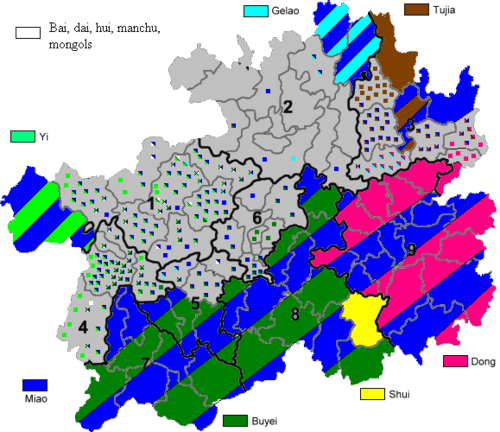
The PRC's Constitution and laws guarantee equal rights to all ethnic groups in China and help promote ethnic minority groups' economic and cultural development[33] One notable preferential treatment ethnic minorities enjoy was their exemption from the population growth control of the One-Child Policy. Additionally, ethnic minorities enjoy other special exemptions which vary by province- these include lower tax thresholds and lower required scores for entry into university. The use of these measures to raise ethnic minorities' human capital is seen by the central government as important for improving the economic development of ethnic minorities. Ethnic minorities are represented in the National People's Congress as well as governments at the provincial and prefectural levels. Some ethnic minorities in China live in what are described as ethnic autonomous areas. These "regional autonomies" guarantee ethnic minorities the freedom to use and develop their ethnic languages, and to maintain their own cultural and social customs. In addition, the PRC government has provided preferential economic development and aid to areas where ethnic minorities live. Furthermore, the Chinese government has allowed and encouraged the involvement of ethnic minority participation in the party. Even though ethnic minorities in China are granted specific rights and freedoms, many ethnic minorities still have headed towards the urban life in order to obtain a well paid job.[34]
Minorities have widely benefited from China's minimum livelihood guarantee program (known as the dibao) a programme introduced nationwide in 1999 whose number of participants had reached nearly twenty million by 2012. The nature of the selection process entails that the programme's providers be proactive and willing in seeking out impoverished prospective participants, as opposed to more comprehensive welfare schemes such as the Urban Resident Basic Medical Insurance Scheme (URBMI), which is universally implemented. As such, the selection process for participants in the dibao programme has generated a perception among observers of the scheme that this programme have been used to mitigate dissent and neutralize any threat to the government that could lead to unrest- including negative performance evaluations of local officials.
Undistinguished ethnic groups
"Undistinguished" ethnic groups are ethnic groups that have not been officially recognized or classified by the central government. The group numbers more than 730,000 people, and would constitute the twentieth most populous ethnic group of China if taken as a single group. The vast majority of this group is found in Guizhou Province.
These "undistinguished ethnic groups" do not include groups that have been controversially classified into existing groups. For example, the Mosuo are officially classified as Naxi, and the Chuanqing are classified as Han Chinese, but they reject these classifications and view themselves as separate ethnic groups.
Citizens of mainland China who are of foreign origin are classified using yet another separate label: "foreigners naturalized into the Chinese citizenship" (外国人入中国籍). However, if a newly naturalized citizen already belongs to a recognized existing group among the 56 ethnic groups, then he or she is classified into that ethnic group rather than the special label.
Religions and their most common affiliations
- Buddhism/Taoism: the Miao (minority), Lisu (minority), Bai, Bulang, Dai, Jinuo, Jing, Jingpo, Mongol, Manchu, Naxi (including Mosuo), Nu, Tai, Tibetan, Zhuang (minority), Yi (minority), and Yugur ("Yellow Uyghurs").[35]
- Protestant Christianity: the Lisu (70%, see Lisu Church)
- Eastern Orthodox Christianity: the Russians
- Judaism: Kaifeng Jews
- Islam: the Hui, Uyghurs, Kazakhs, Dongxiang people, Kyrgyz people, Salar, Tajiks, Uzbeks, Bonans and Tatars.[36]
- Shamanism/Animism: Daur, Ewenkis, Oroqen, Hezhen, Derung.
See also
- Affirmative action in China
- Han Chinese subgroups
- China National Ethnic Song and Dance Ensemble
- Chinese nationality law
- Demographics of the People's Republic of China and Taiwan
- Demographics of China
- Ethnic groups in Chinese history
- Ethnic issues in China
- Graphic pejoratives in written Chinese
- Human rights in China
- List of China administrative regions by ethnic group
- List of endangered languages in China
- List of ethnic groups in China
- Minzu University of China, a university in Beijing designated for ethnic minorities.
- Secession in China
- Sinocentrism
- Taiwanese aborigines
- Undistinguished ethnic groups in China
- Unrecognized ethnic groups in China
- Zhonghua minzu
Notes
References
- "Ethnic Groups in China". English.gov.cn. 26 August 2014.
- Wang Guanqun, ed. (28 April 2011). "Han Chinese proportion in China's population drops: census data". English.news.cn. Archived from the original on 2 May 2011.
- https://www.ethnologue.com/
- https://glottolog.org/glottolog/family
- https://www.ethnologue.com/subgroups/chinese
- https://www.chinadaily.com.cn/ethnic/2009-08/18/content_8582984.htm
- https://www.ethnologue.com/
- http://www.davidpbrown.co.uk/help/top-100-languages-by-population.html
- https://www.eupedia.com/genetics/regional_dna_project_china_mongolia.shtml
- https://www.ethnologue.com/subgroups/chinese
- Constitution of the People's Republic of China Archived 23 May 2006 at the Wayback Machine, 4 December 1982. Retrieved 27 February 2007.
- "China's Fresh Approach to the National Minority Question," by George Moseley, The China Quarterly
- Bulag, Uradyn (2010). "Alter/native Mongolian identity". In Perry, Elizabeth; Selden, Mark (eds.). Chinese Society: Change, Conflict, and Resistance. Taylor & Francis. p. 284.
- Lee Lawrence. (3 September 2011). "A Mysterious Stranger in China". The Wall Street Journal. Accessed on 31 August 2016.
- Harrell, Stephan (1996). Cultural encounters on China's ethnic frontiers. Seattle: University of Washington Press. ISBN 978-0-295-97380-7.
- Michaud J., 2009 Handling Mountain Minorities in China, Vietnam and Laos : From History to Current Issues. Asian Ethnicity 10(1): 25–49.
- Blaut, J. M. (1987). "The Theory of National Minorities". The National Question: Decolonizing the Theory of Nationalism. London: Zed Books. ISBN 978-0-86232-439-1.
- Ma, Rong (June 2010). "The Soviet Model's Influence and the Current Debate on Ethnic Relations". Global Asia.
- Hartford Seminary Foundation (1941). The Moslem World, Volumes 31–34. Hartford Seminary Foundation. p. 182. Retrieved 8 May 2011.
- American Asiatic Association (1940). Asia: journal of the American Asiatic Association, Volume 40. Asia Pub. Co. p. 660. Retrieved 8 May 2011.
- Mullaney, Thomas (2010). "Seeing for the State: The Role of Social Scientists in China's Ethnic Classification Project". Asian Ethnicity. 11 (3): 325–342. doi:10.1080/14631369.2010.510874.
- Kaup, Katherine Palmer (2002). "Regionalism versus Ethnic nationalism". The China Quarterly. 172: 863–884. doi:10.1017/s0009443902000530.
- Mullaney, Thomas (2004). "Ethnic Classification Writ Large: The 1954 Yunnan Province Ethnic Classification Project and its Foundations in Republican-Era Taxonomic Thought". China Information. 18 (2): 207–241. doi:10.1177/0920203X04044685.
- Gladney, Dru C. (1994). "Representing Nationality in China: Refiguring Majority/Minority Identities". The Journal of Asian Studies. 53 (1): 92–123. doi:10.2307/2059528. JSTOR 2059528. S2CID 162540993.
- "China - Ethnolinguistic Groups 1983". University of Texas Libraries. 1983. Retrieved 20 September 2019.
- Oakes, Timothy S. (1997). "Ethnic tourism in rural Guizhou: Sense of place and the commerce of authenticity". In Picard, Michel; Wood, Robert Everett (eds.). Tourism, ethnicity, and the state in Asian and Pacific societies. Honolulu: University of Hawai'i Press. ISBN 978-0-8248-1863-0.
- Hillman, Ben (2003). "Paradise under Construction: Minorities, Myths and Modernity in Northwest Yunnan" (PDF). Asian Ethnicity. 4 (2): 177–190. doi:10.1080/14631360301654.
- Perry, Elizabeth J.; Selden, Mark; Uradyn Erden-Bulag. "Alter/native Mongolian identity: From nationality to ethnic group". Chinese Society: Change, conflict and resistance. Routledge. pp. 261–287. ISBN 978-0-203-85631-4.
- Xiaobing Li, and Patrick Fuliang Shan, Ethnic China: Identity, Assimilation and Resistance, Lexington and Rowman & Littlefield, 2015.
- Hillman, Ben (2006). "Macho Minority: Masculinity and Ethnicity on the Edge of Tibet" (PDF). Modern China. 32 (2): 251–272. doi:10.1177/0097700405286186. Archived from the original (PDF) on 6 February 2016.
Despite tremendous diversity among this broad and dubious ethnic category, the Han became the personification of the new nation and a symbol of modernity and progress. The new Communist Party leaders continued this project, presenting the Han peoples as the harbingers of modernity and progress, a beacon to the non- Han peoples of the political periphery who found themselves unwitting members of a new nation-state defined by clear borders (...) Ethnic minorities entered the national imagination as the primitive Other against which China’s modern national identity could be constructed.
- "Taiwanese Aborigines – the Natives of Taiwan". Taichung.guide. 26 July 2016. Retrieved 27 November 2016.
- "MINORITIES IN CHINA | Facts and Details". Factsanddetails.com.
- "Constitution of the People's Republic of China".
- Yardley, Jim (11 May 2008). "China Sticking With One-Child Policy". The New York Times. Retrieved 20 November 2008.
- "Ethnic Groups". China.org.cn. Retrieved 7 March 2019.
- Jackie Armijo (Winter 2006). "Islamic Education in China". Harvard Asia Quarterly. 10 (1). Archived from the original on 28 September 2007.
Further reading
- Tang, Wenfang and He, Gaochao. "Separate but Loyal: Ethnicity and Nationalism in China." Policy Studies 56. East–West Center.
- China Ethnic Statistical Yearbook 2016
External links
- Chinese National Minorities
- The Ethnic Publishing House: on customs and autonomous places (in Simplified Chinese)
- China National Ethnic Song & Dance Ensemble
- Brief description of Chinese ethnic minority groups
- Descriptions of each ethnic minority group (china.org.cn)
- Guarantee of Rights and Interests of Ethnic Minorities
- China: Minority Exclusion, Marginalization and Rising Tensions, report by Minority Rights Group and Human Rights in China, April 2007
- Regional Ethnic Autonomy Law
- Downloadable article: "Evidence that a West-East admixed population lived in the Tarim Basin as early as the early Bronze Age" Li et al. BMC Biology 2010, 8:15.
